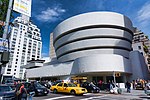Henry Phipps House
Demolished buildings and structures in ManhattanFifth AvenueHouses in ManhattanManhattan building and structure stubsUpper East Side
The Henry Phipps House was a mansion located on 1063 Fifth Avenue in the Upper East Side in Manhattan, New York City. It was constructed for Henry Phipps and demolished after his death in 1930. The entire marble facade was however stripped and shipped off by his widow to their daughter Amy's country estate “Templeton” to a field in Brookville, New York.Parts of the marble were later repurposed to renovate "Templeton" in 2013.
Excerpt from the Wikipedia article Henry Phipps House (License: CC BY-SA 3.0, Authors).Henry Phipps House
5th Avenue, New York Manhattan
Geographical coordinates (GPS) Address Nearby Places Show on map
Geographical coordinates (GPS)
| Latitude | Longitude |
|---|---|
| N 40.78243 ° | E -73.95968 ° |
Address
5th Avenue 1060
10128 New York, Manhattan
New York, United States
Open on Google Maps








